Influence of the Government Department on the Production Capacity Reserve of Emergency Enterprises Based on Multi-Scenario Evolutionary Game
Abstract
1. Instruction
- (1)
- What factors will affect the strategic choice of the local government and SEEs?
- (2)
- Under the reward and punishment mechanism of the central government, how is the optimal ESS of the material capacity reserve system of the local government and SEEs formed?
- (3)
- What are the differences in the factors that affect the strategic choices of the government and SEEs under different scenarios?
2. Literature Review
2.1. Research on Emergency Supplies Reserve
2.2. Application of Evolutionary Game Theory
3. Model Construction and Analysis
3.1. Problem Descriptions
3.2. Research Hypothesis
- (1)
- The strategy set adopted by government departments when facing the problem of the emergency supplies reserve of SEEs is {active encouragement policy, mere formality policy} [49], in which the probability of “active encouragement policy ” being selected by the local government is , and the probability of “mere formality policy ” being selected by the local government is . It is assumed that under the influence of government policies, the set of possible strategies taken by an enterprise is {reserve , no reserve }. The probability of choosing the strategy of “reserve ” is and the probability of choosing the strategy of “not reserve ” is . It is assumed that the probability of an emergency event occurring in the enterprise’s reserve period is , and the probability of no emergency events occurring is .
- (2)
- When the local government chooses the strategy of “active encouragement policy ”, the local government will give preferential policies to SEEs. In addition, enterprises that implement the strategy of security emergency material production capacity reserve will be given a one-time subsidy , reduced tax rates and tax reduction and exemption policies. The taxes to be paid by enterprises are recorded as . When the enterprise chooses the “reserve ” strategy, the potential benefits obtained by the government department from the relatively relieved pressure to deal with emergencies is . The local government department takes active encouragement policies and the enterprises actively reserve emergency supplies, so that the local government can obtain additional revenue, including recognition of the public and stability of the society, which is recorded as . When the enterprise chooses the “no reserve” strategy under this policy, the additional revenue of local government departments will be reduced to in proportion. The regulatory cost and base construction cost paid by the government are , and the enterprise’s income tax payable is . It can be seen that is the total sales revenue obtained after the enterprise chooses the reserve strategy, and is the reduced tax rate.
- (3)
- When the local government chooses the “mere formality policy” strategy, regardless of whether the enterprise chooses the “reserve” strategy or the “no reserve” strategy, the local government will not implement preferential policies , one-time subsidy , reduced tax rates, tax reduction or exemption policies measures for SEEs. At the same time, the local government will leave the supervision cost that should have been paid by the SEEs. As the local government adopts a policy of “mere formality” and the enterprise adopts a strategy of “no reserve of production capacity”, the government will not be able to properly respond to emergency events. The economic loss that the local government needs to bear is , and the loss of public trust of the local government is . Under this policy, if the enterprise chooses the “reserve” strategy, the loss of public trust in local government department will be reduced to in proportion.
- (4)
- When the security emergency enterprise chooses the “reserve ” strategy of emergency supplies, the basic income obtained by the enterprise choosing the reserve strategy is . The enterprise’s income tax payable is , of which is the total sales revenue of the enterprise choosing the reserve strategy and is the standard tax rate of enterprise income tax levied by the government department. The cost required by the enterprise for the emergency supplies reserve is . It includes the production capacity building, management cost and maintenance cost of material reserves. The reserve capacity for emergency supplies of the enterprise is recognized by the government and the public, and the social reputation benefit brought to the enterprise is . Under the “mere formality policy” of the local government department, the security emergency materials are consciously stored by the enterprise. In the event of an emergency, the enterprise can actively assist the government department to provide sufficient emergency supplies, thus obtaining multiple public recognition, which is recorded as .
- (5)
- When the enterprise chooses the strategy of “no reserve ” of emergency supplies, the production capacity of some emergency materials will be surplus by the enterprise, and the income of the goods produced with this production capacity is . The enterprise income tax payable is , in which is the total sales revenue of the enterprise choosing the “no reserve” strategy, and is the standard tax rate of the enterprise income tax levied by the government department. If the enterprise does not reserve materials, when an emergency event occurs, the enterprise cannot perform its social responsibilities well and is under the pressure of public opinion. This not only damages the image of the enterprise, but also affects the normal production and operation activities of the enterprise. The enterprise loss caused is recorded as . Under the influence of the government’s “active encouragement policy”, the enterprise still chooses the strategy of no reserve of emergency supplies, which may cause double losses for the enterprise, and is recorded as . The specific information of relevant parameters is shown in Table 1. (Note: Among them, the income tax payable (refunded) in the current period or the income tax payable approved by the tax authority in the current period is = taxable income * tax rate—exemption of enterprise income tax for eligible enterprises—actual paid income tax, income tax payable = total income—non taxable income—non exempt income).
3.3. Construction of Evolutionary Game Model between the Local Government Department and SEEs
3.3.1. Evolutionary Game Model between the Local Government Departments and SEEs
3.3.2. Stability Analysis of Evolutionary Game Model between Local Government Departments and SEEs
- (1)
- When (i.e., ), is divided into the following two cases for discussion and analysis:
- (2)
- When (i.e., ), is divided into the following two cases for discussion and analysis:
- (1)
- When the total payoff of the active encouragement policies adopted by the local government department are greater than the total payoff of the mere formality policies adopted by them, the government department will choose the active encouragement policy. Assuming that the active encouragement policy of the local government department can play a better role in promoting enterprises to choose emergency supplies reserves, the evolutionary track of local government departments and SEEs will tend to {active encouragement policy, reserve}. This situation shows that the local government departments have achieved the expected effect in terms of publicity and incentive policies on the issue of security emergency supplies reserves. Reasonable active encouragement policies not only play an effective incentive role for enterprises, but also make enterprises and the public aware of the importance of emergency supplies reserves. When an emergency occurs, this ideal strategy can enable the local government and SEEs to be recognized by the public and gain benefits from social stability at the same time, and also enable the good image of the government and enterprises to be established in the public mind.
- (2)
- When the active encouragement policies of local government departments are ineffective, the evolutionary track of local government departments and SEEs will tend to {active encouragement policy, no reserve}. On the one hand, it shows that the total payoff of the SEE when it chooses the reserve strategy is less than the total payoff of the no reserve strategy. At this time, the enterprise will suffer less losses and will also be supported by the policy of the government department. The enterprise will choose “free riding”, which leads to the failure to establish a joint emergency supplies reserve model between the government and the enterprise. On the other hand, when government departments need to deal with emergency events that cause large social losses, even if the problem of the emergency supplies reserve of government departments is regarded as a very essential thing, then enterprises should be encouraged to actively reserve through government incentive policies. However, if the government publicity is not enough, and the incentive threshold is set unreasonably, it is difficult to achieve coordinated reserves between the government and enterprises.
- (3)
- When the total payoff of the active encouragement policies adopted by the local government department are less than the total payoff of the mere formality policies adopted by them, assuming that the government’s policies do not play a role in enterprises, then the evolutionary track of local government departments and SEEs will tend to {mere formality policy, no reserve}. It shows that if the frequency of emergency events is low and cannot cause large social losses, the importance of the security emergency supplies reserve has not been fully recognized by the government and enterprises. Local government departments should have a sense of crisis, assess the probability of an emergency and the social losses it will cause, formulate reasonable incentive measures and make emergency plans. In the following, the central government punishment mechanism can be introduced to constrain the regulatory actions of local governments.
- (4)
- When the government policy can be effectively implemented, with the increasing policy support from the government, then the huge financial expenditure will bring heavy burden to the government departments. At this time, the evolutionary track of local government departments and SEEs will tend to {mere formality policy, reserve}. Therefore, when formulating incentive policies, government departments should not only promote the selection of emergency supplies reserve strategies by SEEs in the short term, but also consider the economic capacity of local governments themselves.
3.4. Construction and Analysis of Evolutionary Game Model between the Local Government and SEEs under Central Government Punishment Mechanism
3.4.1. Evolutionary Game Model between the Local Government and SEEs under Central Government Punishment Mechanism
- (1)
- The total benefit of punishing local governments that adopt mere formality policies are less than the total benefit of the local governments that adopt active encouragement policies, which is expressed as , that is, .
- (2)
- Under the punishment mechanism of the central government, the active encouragement policy of local governments needs to play their role. The total payoff of the SEEs that adopt the strategy of emergency supplies reserve under the influence of the local government’s incentive policies such as policy preference, one-time subsidy, reduced tax rates, tax reduction and exemption policies are greater than that of the SEEs that adopt the strategy of no reserve, which is expressed as , that is, .
3.4.2. Stability Analysis of Evolutionary Game Model between the Local Government Department and SEEs under Central Government Punishment Mechanism
4. Analysis of Stability Strategy and Numerical Simulation Results under Scenario Deduction
4.1. Scenario Hypothesis Analysis
- (1)
- The occurrence of emergency events triggered an increase in public opinion, which is a double-edged sword for the government and enterprises. In the short term, the additional benefits brought by the formulation of feasible response policies by the local government department are far greater than other economic losses and losses of public trust, playing a positive role in promoting social development. Similarly, the impact of enterprise reputation gains and losses will also increase, which is consistent with scenario 1.
- (2)
- Once an emergency occurs, the government, as the supervisor and direct stakeholder of the society, will suffer a large social loss. The social risk is assessed by the government department and the government will pay attention to the reserve of the enterprise’s emergency supplies production capacity under the influence of perceived risk. As the public pays less attention to the enterprise, the enterprise is less affected by emergency events, and the value of enterprise reputation and loss is relatively small and at a low level, which is consistent with the deduction of Scenario 2.
- (3)
- The central government department will decide whether to reward or punish the local government according to the social harm degree of the emergency event and the control effect of the government department. When the local government departments become a mere formality and the enterprises do not reserve production capacity, the central government will give reasonable punishment to the local government for acts of inadequate supervision during the outbreak and impact of the emergency event, which is consistent with the deduction of Scenario 3.
4.2. Analysis on the Influencing Factors of Strategy Evolution of the Local Government Department and SEEs in Scenario 1
- (1)
- (2)
- (3)
- (1)
- The impact of the change of emergency event probability on the dynamic evolution of local governments and SEEs.
- (2)
- The impact of different probabilities of the government’s choice to active encouragement policies on the evolution of SEEs.
- (3)
- The impact of the local government’s policy preference , one-time subsidy and government subsidized tax rate on the evolution of government departments and SEEs.
- (4)
- The impact of the additional benefits on the evolution of the local government department.
- (5)
- The impact of the economic loss and loss of public trust on the evolution of the local government department.
- (6)
- The impact of enterprise social reputation benefits and enterprise losses on the evolution of SEEs.
4.3. Analysis on the Influencing Factors of Strategy Evolution of Local Government Departments and SEEs in Scenario 2
- (1)
- (2)
- (3)
- (1)
- The impact of the change of emergency event probability on the dynamic evolution of local government and SEEs.
- (2)
- The impact of local government’s policy preference , one-time subsidy and government subsidized tax rate on the evolution of the government department and SEEs.
- (3)
- The impact of the additional benefits on the evolution of the local government department.
- (4)
- The impact of the economic loss and loss of public trust on the evolution of the local government department.
- (5)
- The impact of enterprise social reputation benefits and enterprise losses on the evolution of SEEs.
4.4. Analysis on the Influencing Factors of the Strategic Evolution of the Local Government Department and SEEs under the Central Government Punishment Mechanism in Scenario 3
- (1)
- The impact of introducing the central government punishment mechanism on the evolution of the local government department and SEEs.
- (2)
- The impact of the central government’s punishment mechanism on the dynamic evolution results of enterprise social reputation benefits and enterprise losses.
5. Conclusions
- (1)
- From the evolution results of Scenario 1, we can see that the evolution system of local governments and SEEs will have two possible stable results: {mere formality policy, no reserve} and {active encouragement policy, reserve}. The ideal state of evolution of the local government and SEEs can be achieved through appropriate policy preference. In a short period of time, the evolution of SEEs towards reserves can be promoted by one-off subsidies and tax rate reduction policies. For a long time, enterprises will have the speculative mentality of “free riding”, which is not conducive to the realization of the enterprise production capacity escrow model. Both the government and enterprises will pay attention to their social reputation gains, so publicizing and maintaining the good public image of the government and enterprises is conducive to the realization of the joint reserve model for both sides. Similarly, when the government and enterprises perceive large losses, they can also seek cooperation to avoid risks and reduce their own losses.
- (2)
- It can be seen from the evolution results of Scenario 2 that the evolution system of the local government and SEEs will have two possible stable results: {mere formality policy, reserve} and {active encouragement policy, no reserve}. As the local government is threatened by greater risk losses, the government department prefers to choose active encouragement policy to promote enterprise reserves, so as to relieve the pressure of government supervision. The implementation of incentive measures such as policy preference and one-time subsidy has been strengthened, but it has failed to change the direction of enterprises to reserve production capacity. On the contrary, it has increased the financial pressure of the government and stimulated the “free riding” behavior of enterprises. In this scenario, one of the most effective means is to achieve joint reserves by improving the social reputation benefits of the local government and enterprises [52].
- (3)
- From the evolution results of Scenario 3, it can be concluded that the evolution of the game system formed by the local government and SEEs towards the ideal state {active encouragement policy, reserve} can be effectively promoted by the central government’s punishment mechanism. The punishment of the central government has a positive knock-on effect on SEEs, and indirectly affects the strategic choice of enterprises.
- (1)
- The government’s innovation policy has a double effect, so we should pay attention to developing strengths and avoiding weaknesses. The government has introduced a variety of incentive policies. On the one hand, it is to improve the willingness of SEEs to reserve production capacity, which is conducive to the formation of a joint emergency reserve system between the government and enterprises. On the other hand, it is easy to expand the gap between social returns and corporate returns and stimulate the emergence of “free riding” behavior. Therefore, the SEEs escrow system needs to be established and improved by government departments, and the construction level of the emergency supplies production capacity base should be improved to create a scientific and efficient government enterprise cooperation mechanism.
- (2)
- The government department shall publicize the policies, so that enterprises can fully understand the government policies and the actual production capacity reserves of enterprises can be monitored. The government should pay attention to publicizing the good image of security emergency enterprises, and it is important to clarify the reputation mechanism for government enterprise cooperation. At the same time, the punishment implemented by the central government can effectively prevent the inaction of the local government and provide a second line of defense for security emergency reserves.
Author Contributions
Funding
Institutional Review Board Statement
Informed Consent Statement
Data Availability Statement
Conflicts of Interest
Appendix A
Appendix B
| Parameters | Initial Values | Parameters Change under Hypothesis 4 | |||||
|---|---|---|---|---|---|---|---|
| 200 | 400; 600; 800 | 200 | 200 | 200 | 200 | 200 | |
| 2500 | 2500 | 2500 | 2500 | 3000; 3500; 4000 | 2500 | 2500 | |
| 2500 | 2500 | 2500 | 3000; 3500; 4000 | 2500 | 2500 | 2500 | |
| 280 | 280 | 290; 300; 310 | 280 | 280 | 280 | 280 | |
| 1 | 1 | 1 | 1 | 1 | 2;3;4 | 1 | |
| 1 | 1 | 1 | 1 | 1 | 1 | 1.5; 2; 3 | |
| 600 | 600 | 600 | 600 | 600 | 600 | 1000; 1400; 1800 | |
| 600 | 600 | 600 | 600 | 600 | 1000; 1400; 1800 | 600 | |
| 800 | 800 | 800 | 800 | 800 | 800 | 800 | |
References
- Li, Q.Q.; Wang, H.B.; Liu, Y.J.; Ma, N. The Typical Characteristics, Governance Issues and Policy Recommendations of Chinese Collective Action. Think Tank Theory Pract. 2022, 7, 74–82. (In Chinese) [Google Scholar]
- Zhang, H.Y.; Li, S.L. The Connotation, Characteristics and Construction Rationale of Emergency Culture in the Post-Epidemic Era. North. Lit. Stud 2022, 89–96. (In Chinese) [Google Scholar]
- Dash, M.; Shadangi, P.Y.; Muduli, K.; Luhach, A.K.; Mohamed, A. Predicting the motivators of telemedicine acceptance in COVID-19 pandemic using multiple regression and ANN approach. J. Stat. Manag. Syst. 2021, 24, 319–339. [Google Scholar] [CrossRef]
- Sahoo, K.K.; Muduli, K.K.; Luhach, A.K.; Poonia, R.C. Pandemic COVID-19: An empirical analysis of impact on Indian higher education system. J. Stat. Manag. Syst. 2021, 24, 341–355. [Google Scholar] [CrossRef]
- Kusumastuti, R.D.; Arviansyah, A.; Nurmala, A.; Wibowo, S.S. Knowledge management and natural disaster preparedness: A systematic literature review and a case study of East Lombok, Indonesia. Int. J. Disaster Risk Reduct. 2021, 58, 102223. [Google Scholar] [CrossRef]
- Joshi, S. Social network analysis in smart tourism-driven service distribution channels: Evidence from tourism supply chain of Uttarakhand, India. Int. J. Digit. Cult. Electron. Tour. 2018, 2, 255–272. [Google Scholar] [CrossRef]
- Zhang, H. Improvement of Emergency Materials Reserves System in China. Chin. Public Adm. 2009, 3, 44–47. [Google Scholar]
- Sun, Y.; Wu, J.; Liu, C.X.; Zhu, Y.B. Accelerating Construction of Innovative Country to Promote Modernization of China’s Emergency Supplies Reserve System. Bull. Chin. Acad. Sci. 2020, 35. (In Chinese) [Google Scholar]
- Wang, Y.C.; Xie, R.W. Joint Reserve Decision-making of Emergency Supplies in Response to Emergencies. For. Chem. Rev. 2022, 240–262. [Google Scholar]
- Chen, T.; Huang, J. Exploratory Research on the System of China Relief Reserve. Syst. Eng. Procedia. 2012, 99–106. [Google Scholar] [CrossRef]
- Men, H.; Wang, J. Research on Coordination Reserve Optimization Model of Emergency Materials for Work Safety Accidents Based on Scenario Analysis. J. Saf. Sci. Technol. 2017, 13, 64–68. (In Chinese) [Google Scholar]
- Zhang, M.; Kong, Z.J. A Tripartite Evolutionary Game Model of Emergency Supplies Joint Reserve Among the Government. Enterprise and Society. Comput. Ind. Eng. 2022, 169, 108132. [Google Scholar] [CrossRef]
- Friedman, D. Evolutionary Games in Economics. Econometrica. 1991, 59, 637–666. [Google Scholar] [CrossRef]
- Fudenberg, D.; Tirole, J. Game Theory; The MIT Press: Cambridge, UK, 1991. [Google Scholar]
- Fisher, R.A. The Genetic Theory of Natural Selection; Clarendon Press: Oxford, UK, 1930. [Google Scholar]
- Smith, J.M.; Price, G.R. The Logic of Animal Conflict. Nature 1973, 246, 15–18. [Google Scholar] [CrossRef]
- Taylor, P.D.; Jonker, L.B. Evolutionary Stable Strategies and Game Dynamics. Math. Biosci. 1978, 40, 145–156. [Google Scholar] [CrossRef]
- Zhao, D.; Ji, S.; Wang, H.; Jiang, L. How Do Government Subsidies Promote New Energy Vehicle Diffusion in the Complex Network Context? A Three-stage Evolutionary Game Mode. Energy 2021, 230, 120899. [Google Scholar] [CrossRef]
- Chen, J.; Xiong, W.; Xu, L.; Di, Z. Evolutionary Game Analysis on Supply Side of the Implement Shore-to-ship Electricity. Ocean Coast. Manag. 2021, 215, 105926. [Google Scholar] [CrossRef]
- Yuan, Y.; Du, L.; Li, X.; Chen, F. An Evolutionary Game Model of the Supply Decisions between GNPOs and Hospital during a Public Health Emergency. Sustainability 2022, 14, 1156. [Google Scholar] [CrossRef]
- Liu, Y.; Chen, L.; Huang, C.A. Tripartite Evolutionary Game and Simulation Analysis of Transportation Carbon Emission Reduction across Regions under Government Reward and Punishment Mechanism. Sustainability 2022, 14, 10562. [Google Scholar] [CrossRef]
- Whybark, D.C. Issues in Managing Disaster Relief Inventories. Int. J. Prod. Econ. 2007. [Google Scholar]
- Shen, B.; Chen, M.; You, J.; Li, J.; Zhu, W.; Wu, W.; Ji, B.; Wang, X. Establishment of Emergency Medical Supplies System in Mega-cities in Respond to the Public Health Emergencies State. Chin. Hosp. Manag. 2020, 40. (In Chinese) [Google Scholar]
- Chen, Y.H.; Shi, K.J. Emergency Materials Reserve Mode based on Government and Manufacture Joint before Emergencies. Syst. Eng. 2014, 32, 84–90. (In Chinese) [Google Scholar]
- Wang, X.; Li, F.; Liang, L.; Huang, Z.; Ashley, A. Pre-purchasing with Option Contract and Coordination in a Relief Supply Chain. Int. J. Prod. Econ. 2015, 167, 170–176. [Google Scholar] [CrossRef]
- Hu, Z.; Tian, J.; Feng, G. A Relief Supplies Purchasing Model based on A Put Option Contract. Comput. Ind. Eng. 2019, 127, 253–262. [Google Scholar] [CrossRef]
- Hu, Z.; Feng, G. The Model of Joint Emergency Supplies Reserves of Governments and Enterprises based on Option Procurement. Syst. Eng.-Theory Pract. 2018, 38, 2032–2044. (In Chinese) [Google Scholar]
- Zhang, L. Emergency Supplies Reserve Allocation within Government-private Cooperation: A Study from Capacity and Response Perspectives. Comput. Ind. Eng. 2021, 154, 107171. [Google Scholar] [CrossRef]
- Cong, W.; Yu, W. Site Selection Model and Algorithm of Regional Emergency Supplies Reserve Considering Typhoon Scenario. Ind. Eng. Manag. 2020, 25, 68–74. [Google Scholar]
- Ai, Y.; Lu, J.; Zhang, L. The Optimization Model for the Location of Maritime Emergency Supplies Reserve bases and the Configuration of Salvage Vessels. Transp. Res. E Logist. Transp. Rev. 2015, 83, 170–188. [Google Scholar] [CrossRef]
- Coskun, A.; Elmaghraby, W.; Karaman, M.M.; Salman, F. S. Relief Aid Stocking Decisions under Bilateral Agency Cooperation. Socio-Econ. Plan. Sci. 2019, 67, 147–165. [Google Scholar] [CrossRef]
- Liu, J.; Guo, L.; Jiang, J.; Jiang, D.; Liu, R.; Wang, P. A Two-stage Optimization Model for Emergency Material Reserve Layout Planning under Uncertainty in Response to Environmental Accidents. J. Hazard. Mater. 2016, 310, 30–39. [Google Scholar] [CrossRef]
- Olanrewaju, O.G.; Dong, Z.S.; Hu, S. Supplier Selection Decision Making in Disaster Response. Comput. Ind. Eng. 2020, 143, 106412. [Google Scholar] [CrossRef]
- Zhang, W.; Shi, X.; Huang, A.; Hua, G.; Teunter, R.H. Optimal Stock and Capital Reserve Policies for Emergency Medical Supplies Against Epidemic Outbreaks. Eur. J. Oper. Res. 2023, 304, 183–191. [Google Scholar] [CrossRef]
- Sun, J.; Cao, H.; Geng, B.; Tang, Z.; Li, X. Demand Prediction of Railway Emergency Resources Based on Case-based Reasoning. J. Adv. Transp. 2021, 8, 1–10. [Google Scholar] [CrossRef]
- Chen, J.H.; Liu, R.Y. Research on the Mixed Reserve of Emergency Medical Materials and Production Capacity. J. Nanhua Univ. (Soc. Sci. Ed.) 2021, 22, 71–76. (In Chinese) [Google Scholar]
- Adida, E.; DeLaurentis, P.C.; Lawley, M.A. Hospital Stockpiling for Disaster Planning. IIE Trans. 2011, 43, 348–362. [Google Scholar] [CrossRef]
- Du, L.Y.; Qian, L. The Government’s Mobilization Strategy Following a Disaster in the Chinese Context: An Evolutionary Game Theory Analysis. Nat. Hazards 2016, 80, 1411–1424. [Google Scholar] [CrossRef]
- Heetun, S.; Phillip, F.; Park, S. Post-disaster Cooperation Among Aid Agencies. Syst. Res. Behav. Sci. 2018, 35, 233–247. [Google Scholar] [CrossRef]
- Yang, D.; Jiang, M.; Chen, Z.; Nie, P. Analysis on One-off Subsidy for Renewable Energy Projects Based on Time Value of Money. J. Renew. Sustain. Energy. 2019, 11, 025901. [Google Scholar] [CrossRef]
- Qiu, Y.; Shi, M.; Zhao, X.N.; Jing, Y.P. System Dynamics Mechanism of Crossregional Collaborative Dispatch of Emergency Supplies Based on Multi-agent Game. Complex Intell. Syst. 2021, 2, 00303. [Google Scholar]
- Fan, Y.; Yang, S.; Jia, P. Preferential Tax Policies: An Invisible Hand behind Preparedness for Public Health Emergencies. Int. J. Health Policy Manag. 2022, 11, 547–550. [Google Scholar] [CrossRef]
- Liang, Y.R.; Liu, Y.Q. The Evolutionary Game and Stability Analysis of the Regulatory Mechanism of Medical Protective Equipment Market under COVID-19 Epidemic. Chin. J. Manag. Sci. 2020, 30, 85–95. (In Chinese) [Google Scholar]
- Qi, K.; Yang, Z. Multi-scenario Evolutionary Game Analysis of Network Public Opinion Governance in Sudden Crisis. Chin. J. Manag. Sci. 2020, 28, 59–70. [Google Scholar]
- Zhang, N.; Yang, Y.; Wang, X. Game Analysis on the Evolution of Decision-Making of Vaccine Manufacturing Enterprises under the Government Regulation Model. Vaccines 2020, 8, 267. [Google Scholar] [CrossRef] [PubMed]
- Chang, D.; Gui, H.Y.; Fan, R. Scenario Evolution and Simulation of Social Security Emergencies in Megacities — Taking Beijing as an Example. J. Beijing Jiaotong Univ. (Soc. Sci. Ed.) 2020, 19, 86–97. (In Chinese) [Google Scholar]
- You, M.; Li, S.; Li, D.; Cao, Q.; Xu, F. Evolutionary Game Analysis of Coalmine Enterprise internal Safety Inspection System in China based on System Dynamics. Resour. Policy 2020, 67, 101673. [Google Scholar] [CrossRef]
- Fei, L.; Wang, Y. Demand Prediction of Emergency Materials using Case-based Reasoning Extended by the Dempster-Shafer Theory. Socio-Econ. Plan. Sci. 2022. [Google Scholar]
- Liang, X.; Chen, Q.Q. Study on the Major Epidemic Prevention and Control under the Mechanism of Government Dynamic Reward and Punishment. Chin. J. Manag. Sci. 2020, 1–12. [Google Scholar]
- Zhang, N.P.; Zhang, Y.L. Study on Decision-making of Government-Enterprise Joint Emergency Reserve Based on Evolutionary Game. J. Wuhan Univ. Technol. (IAME) 2020, 42, 98–102. (In Chinese) [Google Scholar]
- Chen, Q.Q. A Study on the Evolutionary Game of Government and Enterprise for the Production Capacity Reserve of Emergency Materials in Emergencies. Math. Pract. Theory. 2022, 52, 44–52. (In Chinese) [Google Scholar]
- Liu, Y.; Tian, J.; Feng, G.Z.; Zhou, K. A Dynamic Incentive Model for the Prepositioning System of Relief Supplies Based on Reputation Effect. J. Syst. Manag. 2022, 31, 1–15. (In Chinese) [Google Scholar]
- Joshi, S.; Sharma, M.; Das, R.P.; Muduli, K.; Raut, R.; Narkhede, B.E.; Shee, H.; Misra, A. Assessing Effectiveness of Humanitarian Activities against COVID-19 Disruption: The Role of Blockchain-Enabled Digital Humanitarian Network (BT-DHN). Sustainability 2022, 14, 1904. [Google Scholar] [CrossRef]
- Quarshie, A.M.; Leuschner, R. Interorganizational Interaction in Disaster Response Networks: A Government Perspective. J. Supply Chain Manag. 2020, 56, 3–25. [Google Scholar] [CrossRef]
- Joshi, S.; Sharma, M.; Das, R.P.; Rosak-Szyrocka, J.; Zywiołek, J.; Muduli, K.; Prasad, M. Modeling Conceptual Framework for Implementing Barriers of AI in Public Healthcare for Improving Operational Excellence: Experiences from Developing Countries. Sustainability 2022, 14, 11698. [Google Scholar] [CrossRef]



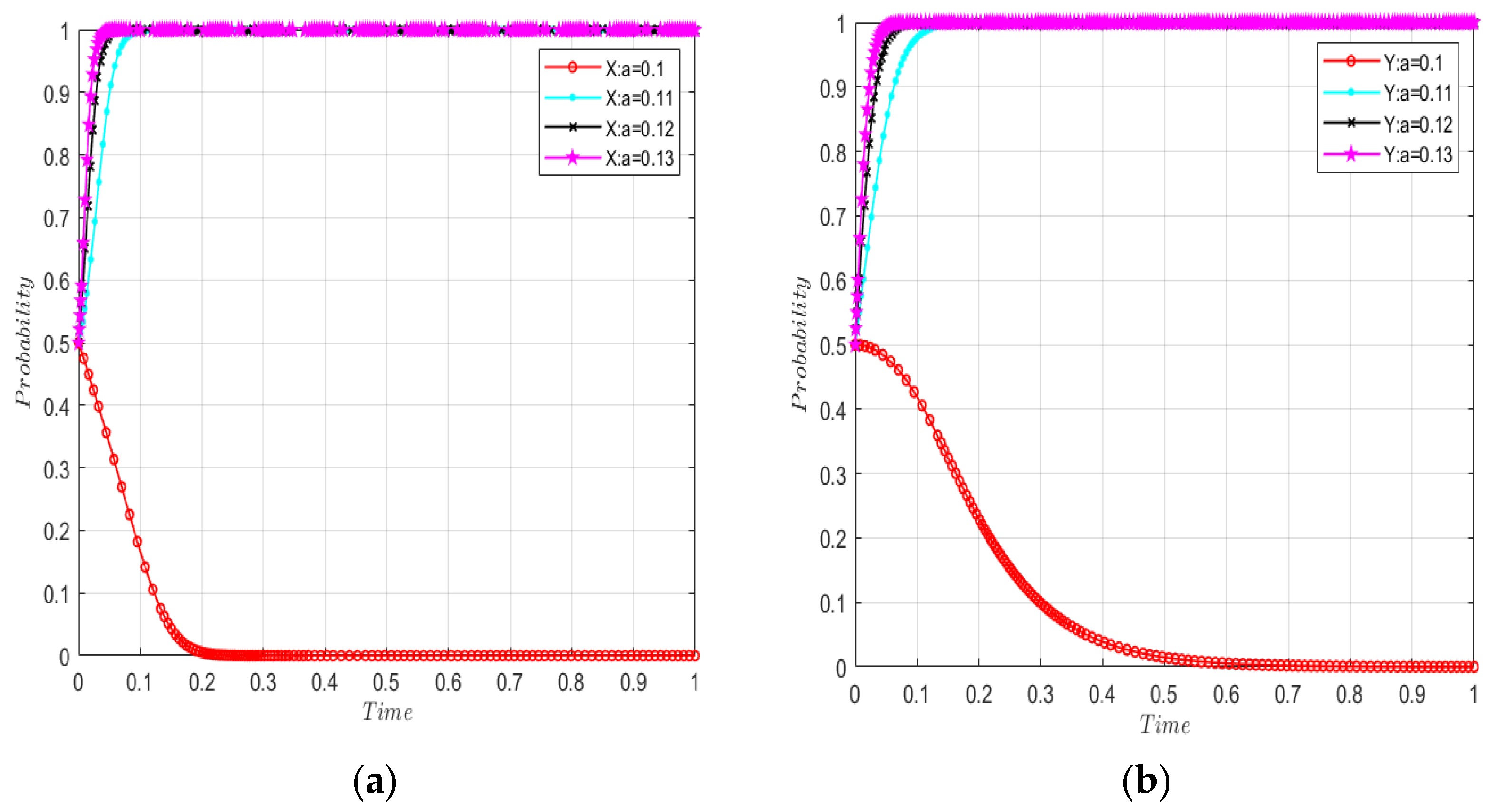
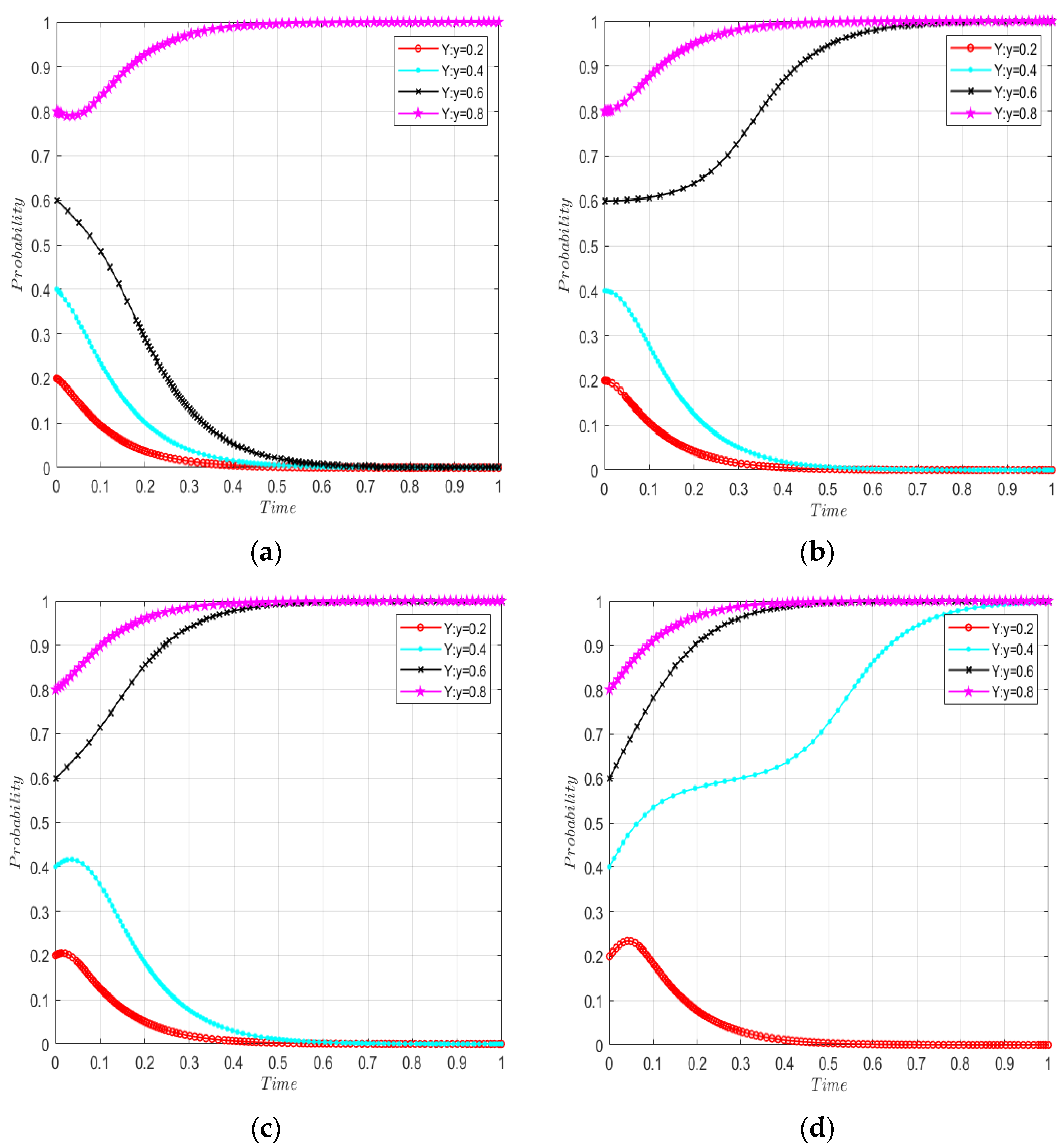
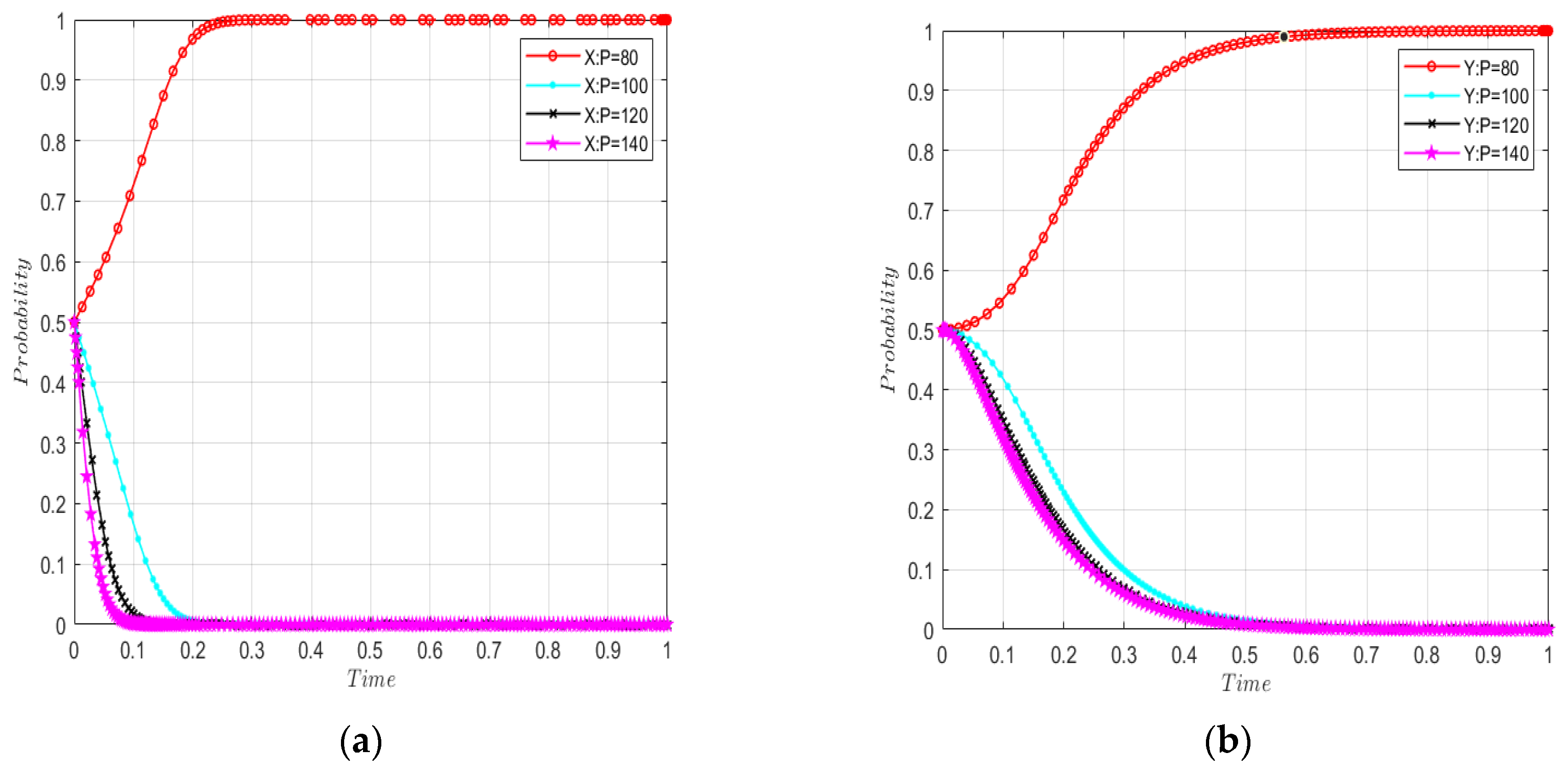
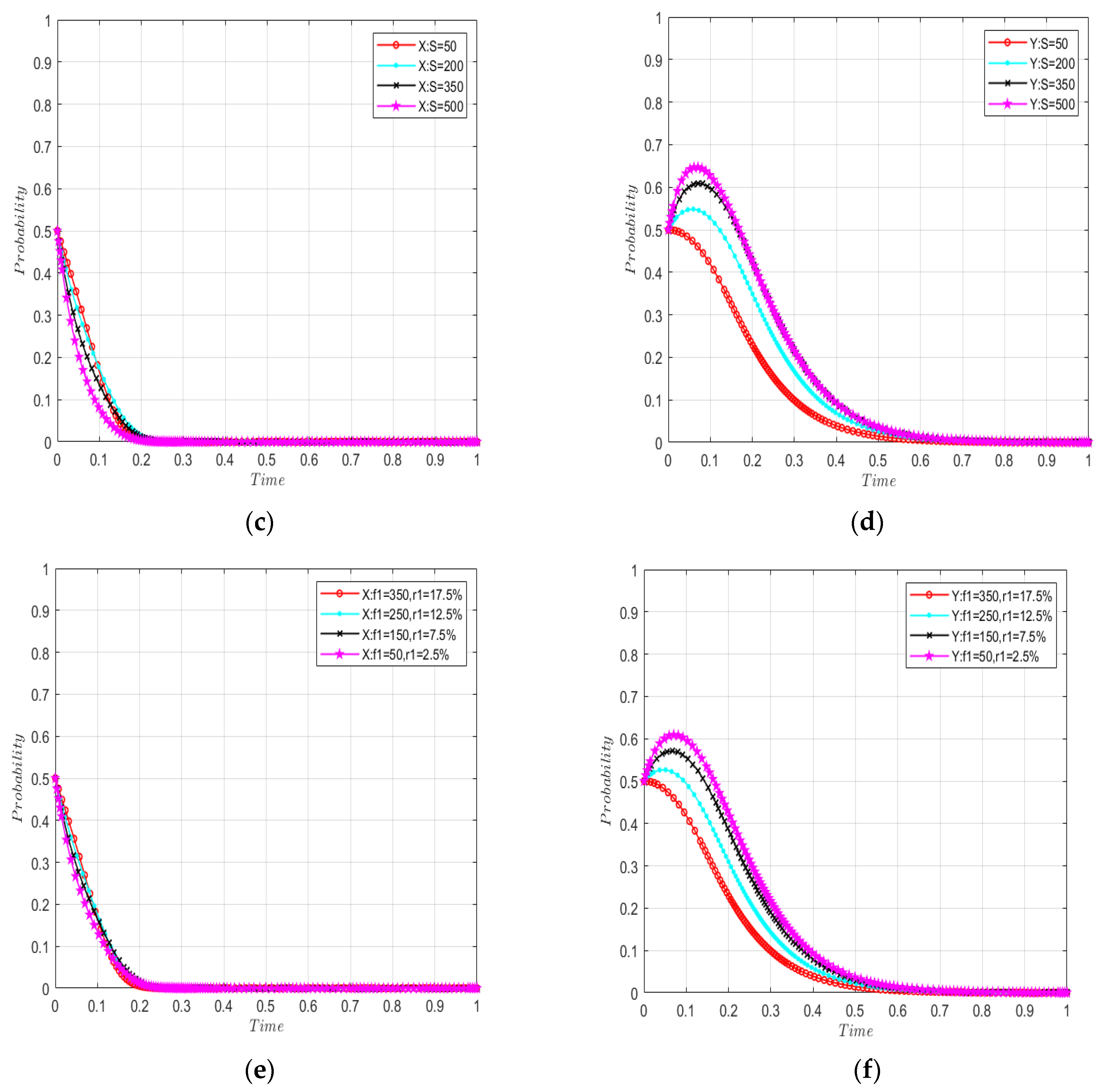
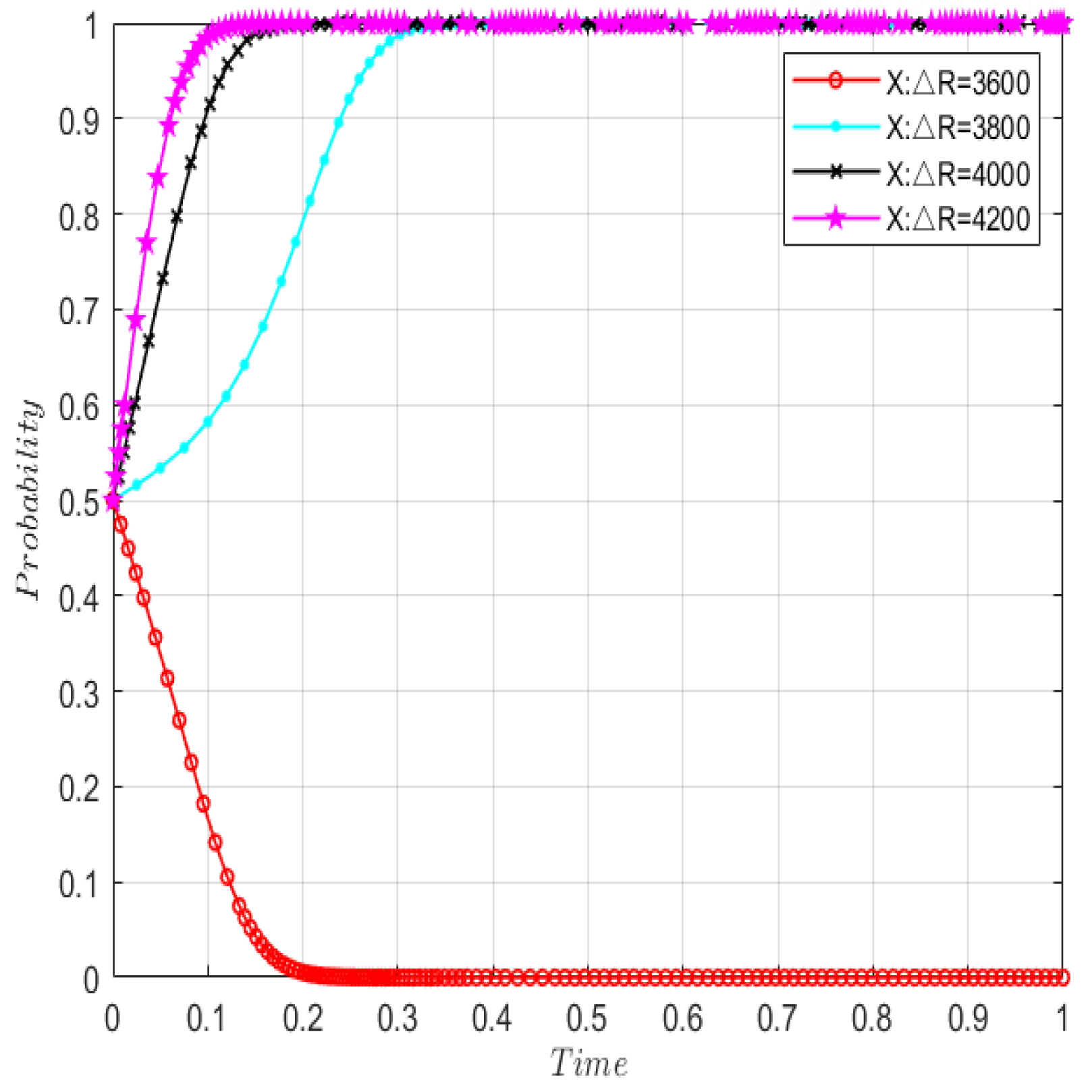

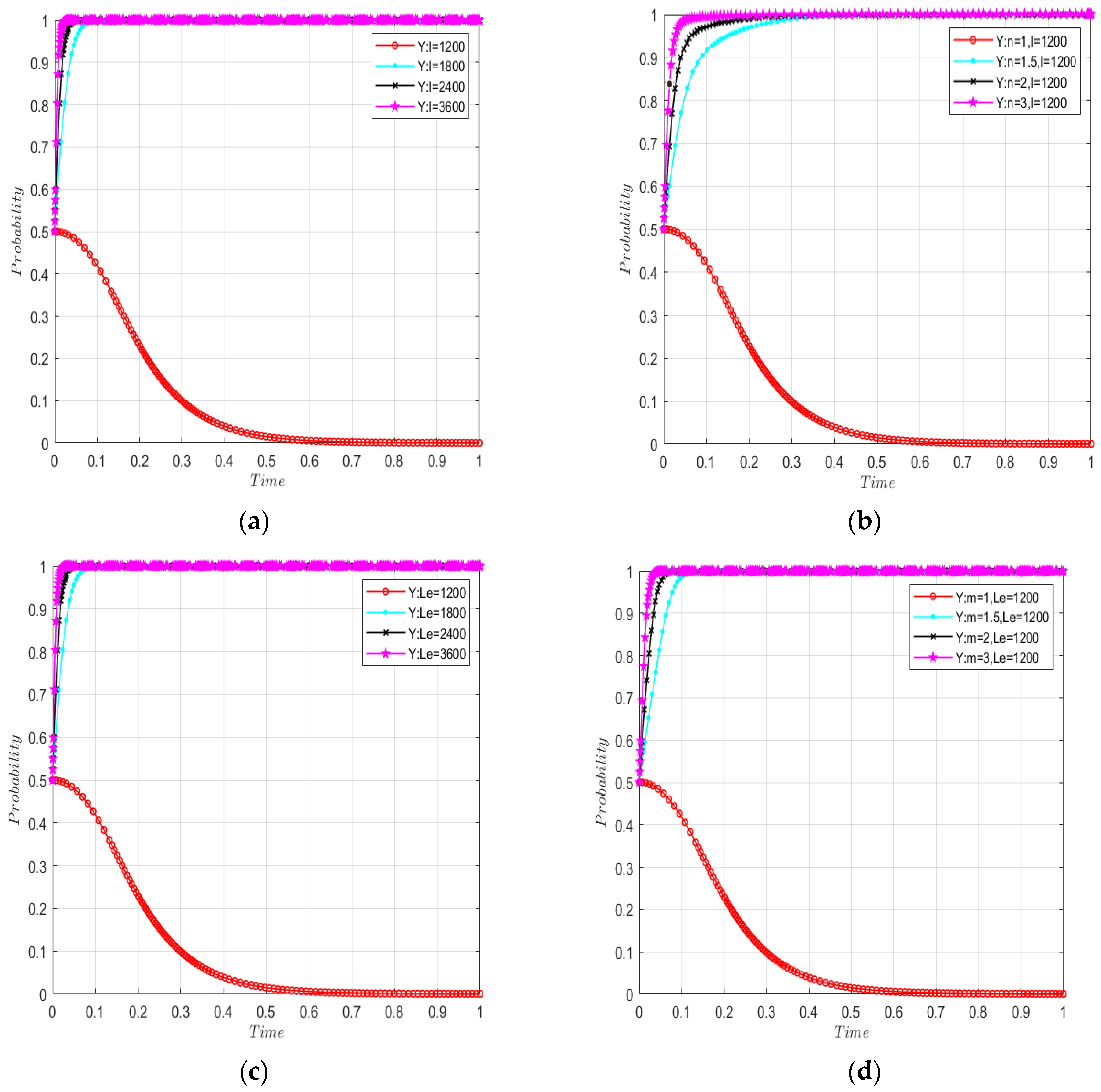
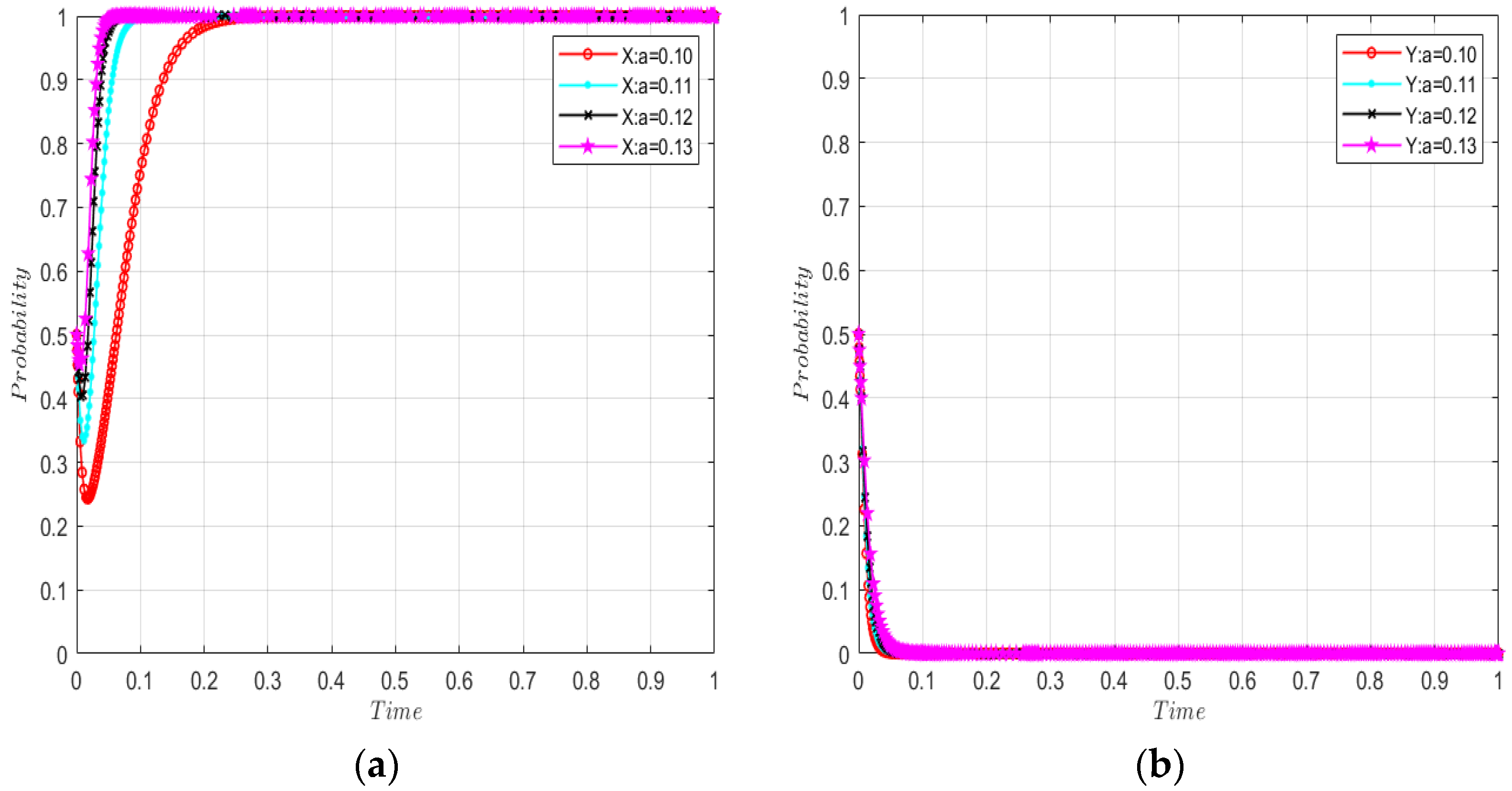
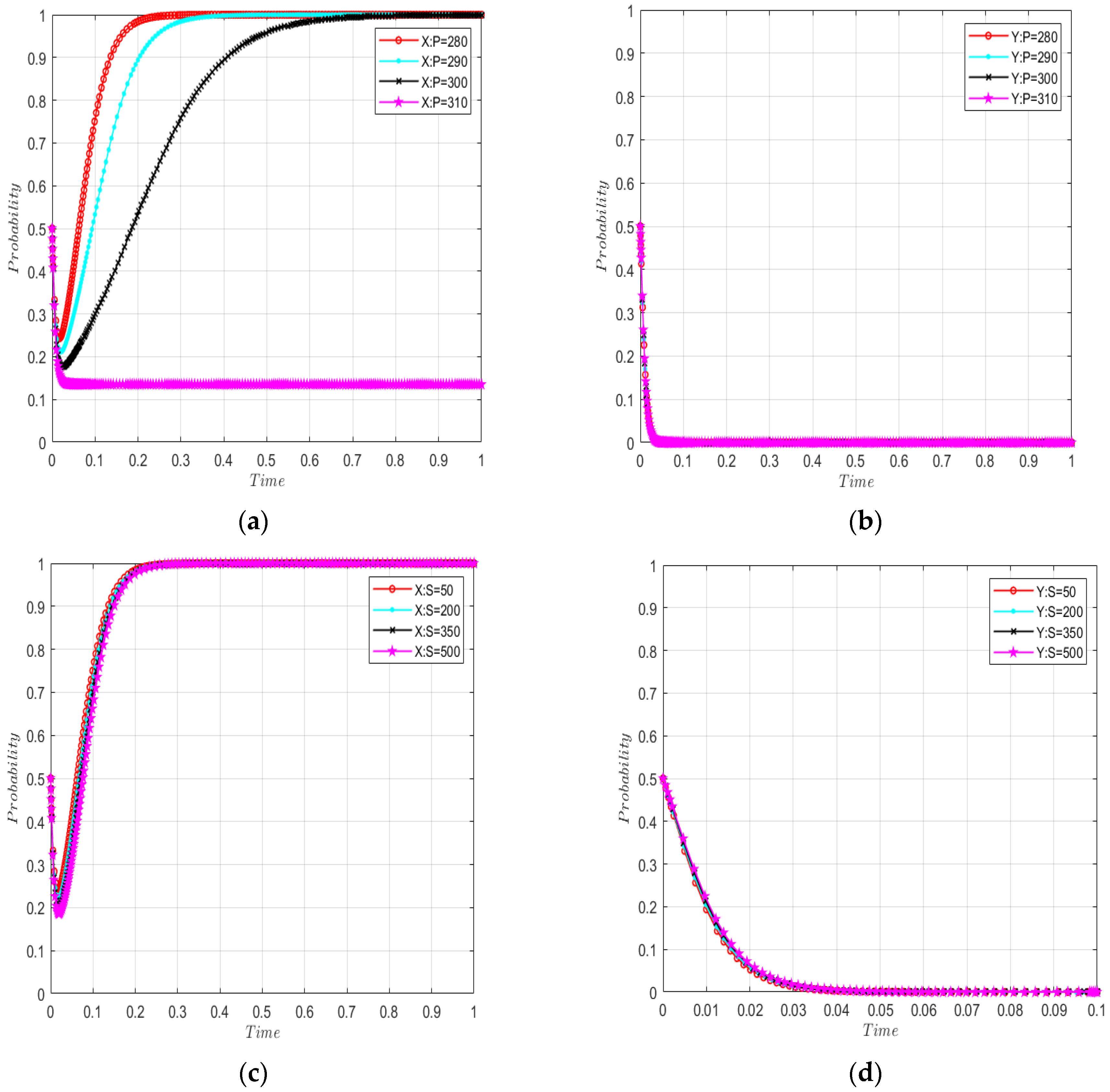



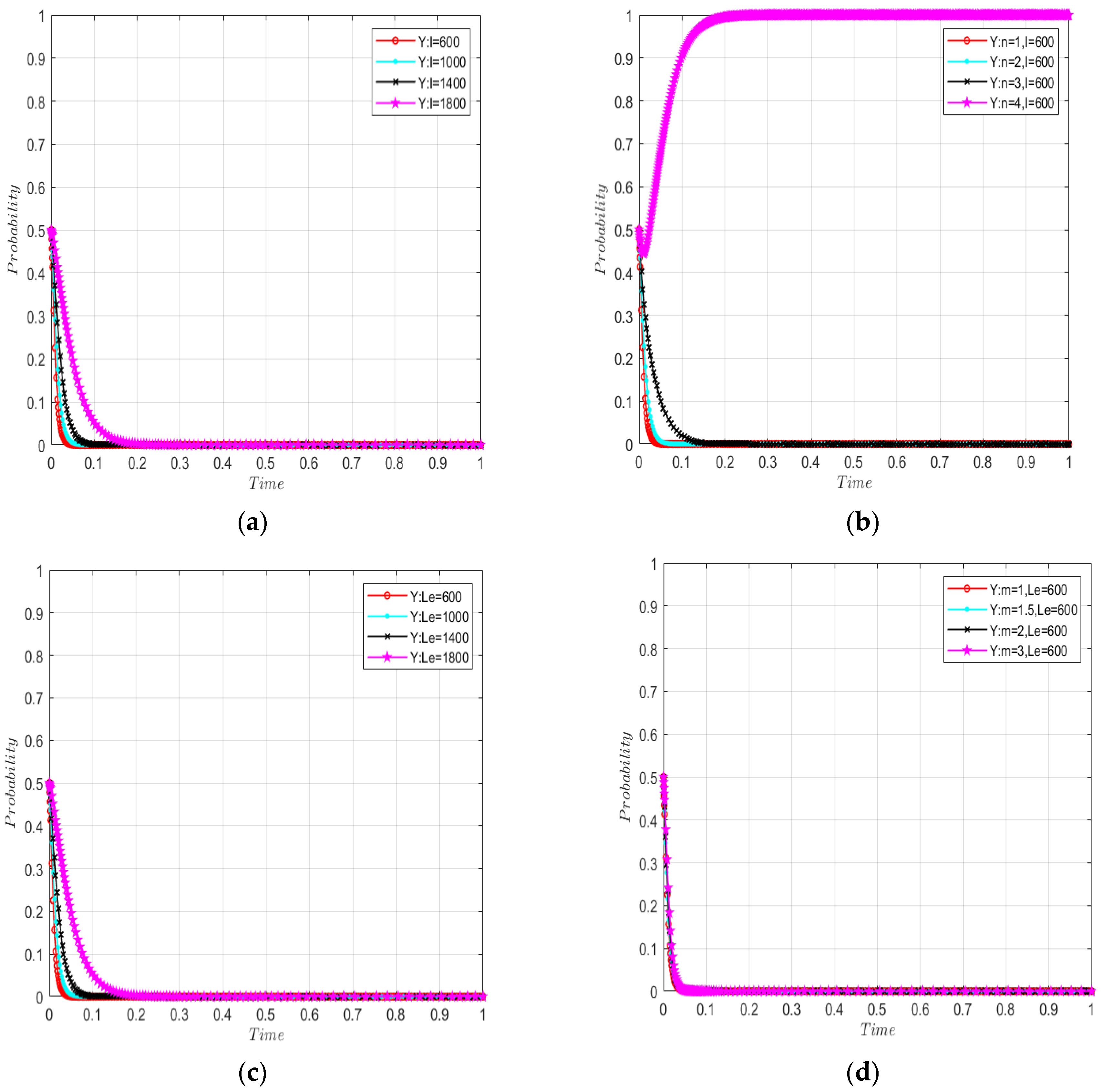
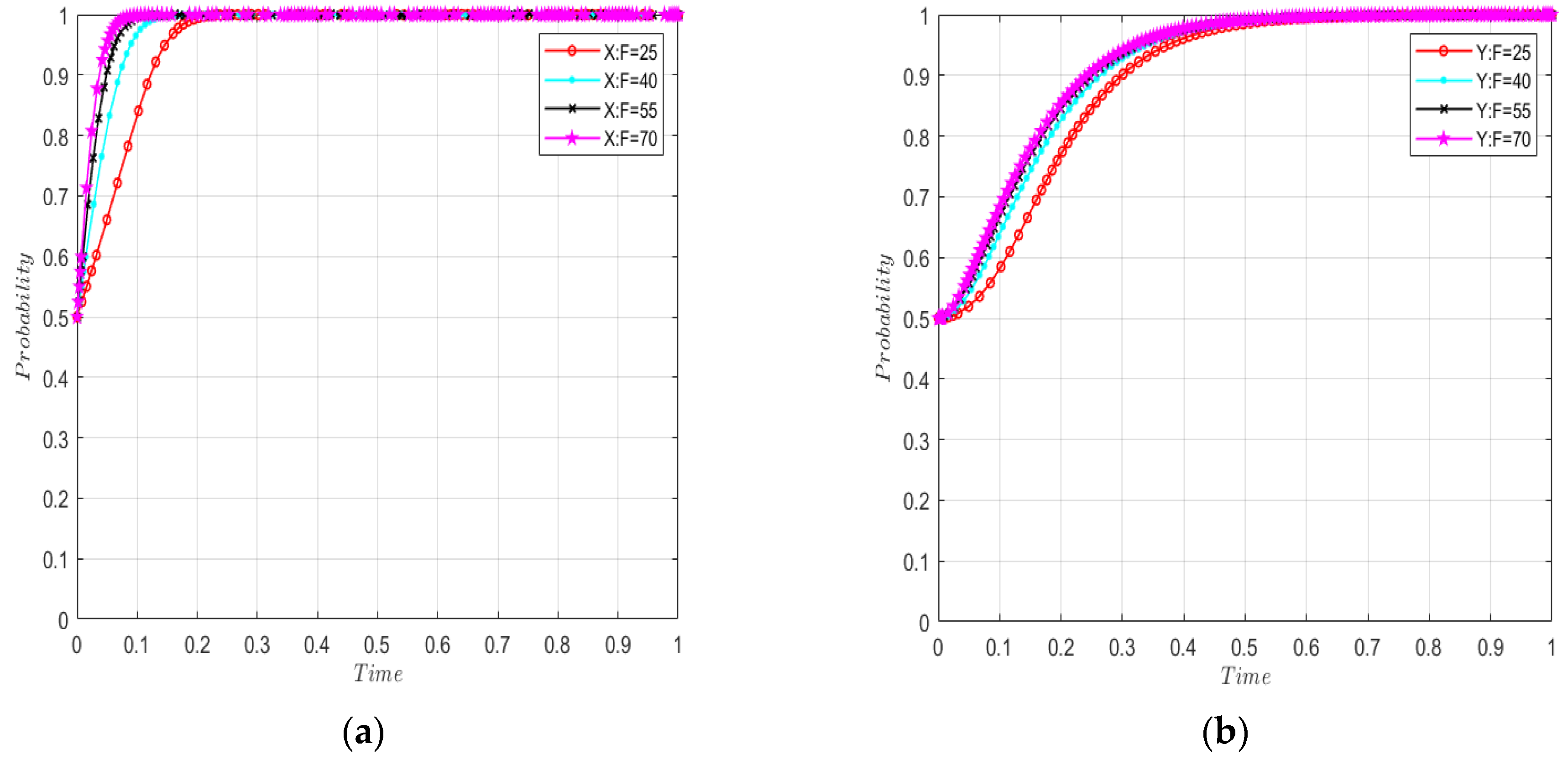

| Parameters | Explanations |
|---|---|
| Occurrence probability of emergency event. | |
| The potential benefits obtained by the local government department due to the reserve strategy of security emergency enterprises. | |
| Additional benefits obtained by the local government due to the positive encouragement policy to gain the recognition of the public and social stability. | |
| When the enterprise chooses the no reserve strategy, the additional revenue of the local government department will be reduced proportionally. | |
| The local government gives policy preference to security emergency enterprises. | |
| One-time subsidy given by the local government to enterprises due to security emergency enterprises’ choice of production capacity reserve strategy. | |
| Supervision cost of the local government department. | |
| Economic losses to be borne by the local government department. | |
| Loss of public trust to be borne by local governments. | |
| As enterprises choose the reserve strategy, the loss of public trust of the local government department is reduced proportionally. | |
| Basic income obtained from the enterprise’s choice of reserve strategy. | |
| Cost incurred by enterprises for emergency supplies reserve. | |
| The benefit from the social reputation of an enterprise. | |
| Under the government’s mere formality policy, enterprises have obtained multiple social reputation benefits due to their choice of reserve strategy. | |
| The income obtained by the enterprise from the products produced by the remaining production capacity of the no reserve strategy. | |
| Enterprise losses caused by the no reserve strategy. | |
| Under the active encouragement policy of the local government, enterprises have suffered multiple enterprise losses due to the no reserve strategy. | |
| Enterprise income tax payable levied by the local government department at tax rate ; the total sales revenue of the reserve strategy selected by the enterprise is . | |
| Enterprise income tax payable levied by the local government department at tax rate ; the total sales revenue of the reserve strategy selected by the enterprise is . | |
| Enterprise income tax payable levied by the local government department at tax rate ; the total sales revenue of the no reserve strategy selected by the enterprise is . |
| Security Emergency Enterprises | |||
|---|---|---|---|
| Reserve E1(y) | No Reserve E2(1 − y) | ||
| Local government departments | active encouragement policy () | ||
| mere formality policy () | |||
| Equilibrium Points | Eigenvalues | Eigenvalues |
|---|---|---|
| Equilibrium Points | Sign | Sign | ||
|---|---|---|---|---|
| 0 | 0 |
| Hypothesis 1 | Hypothesis 2 | Hypothesis 3 | Hypothesis 4 | |||||||||
|---|---|---|---|---|---|---|---|---|---|---|---|---|
| Equilibrium Points | Stability | Stability | Stability | Stability | ||||||||
| ESS | Saddle point | Saddle point | Instability point | |||||||||
| Instability point | Instability point | Saddle point | ESS | |||||||||
| Instability point | Saddle point | Saddle point | ESS | |||||||||
| ESS | Saddle point | Saddle point | Instability point | |||||||||
| 0 | Not equilibrium point | 0 | Not equilibrium point | 0 | Not equilibrium point | 0 | Not equilibrium point | |||||
| Security Emergency Enterprises | |||
|---|---|---|---|
| Reserve (y) | No Reserve | ||
| Local government departments | active encouragement policy () | ||
| mere formality policy () | |||
| Hypothesis 5 | Hypothesis 6 | |||||
|---|---|---|---|---|---|---|
| Equilibrium Points | Det(J) | Stability | Stability | |||
| − | ESS | Saddle point | ||||
| Instability point | Saddle point | |||||
| Instability point | Saddle point | |||||
| ESS | Saddle point | |||||
| 0 | Not equilibrium point | 0 | Not equilibrium point | |||
| Scenario Classification | Specific Description | Initial Variable Adjustment Direction | Hypothesis |
|---|---|---|---|
| Scenario 1 | The strategic evolution of governments and SEEs under the scenario that the issue of emergency supplies reserves has a relatively small impact on the loss of social public trust and economic losses of the local government department, and a relatively large impact on the reputation gains and losses of SEEs. | ; ; ; ; ; | Hypothesis 1 |
| Scenario 2 | The strategic evolution of governments and SEEs under the scenario that the issue of emergency supplies reserves has a relatively large impact on the social public trust loss and economic loss of the local government department, and a relatively small impact on the reputation gains and losses of SEEs. | ; ; ; ; | Hypothesis 4 |
| Scenario 3 | In the outbreak and impact periods of emergency events, the local government department and SEEs behavior and strategy evolution on emergency supplies reserves under the scenario of introducing the central government’s punishment mechanism in the absence of the local government and SEEs. | Hypothesis 5 |
| Parameters | Initial Values | Parameters Change Under Hypothesis 1 | ||||||||
|---|---|---|---|---|---|---|---|---|---|---|
| 0.1 | 0.11; 0.12; 0.13 | 0.1 | 0.1 | 0.1 | 0.1 | 0.1 | 0.1 | 0.1 | 0.1 | |
| 0.5 | 0.5 | 0.5 | 0.5 | 0.5 | 0.5 | 0.5 | 0.5 | 0.5 | 0.5 | |
| 3600 | 3600 | 3800; 4000; 4200 | 3600 | 3600 | 3600 | 3600 | 3600 | 3600 | 3600 | |
| 50 | 50 | 50 | 200; 350; 500 | 50 | 50 | 50 | 50 | 50 | 50 | |
| 0.5 | 0.5 | 0.5 | 0.5 | 0.5 | 0.5 | 0.5 | 0.5 | 0.5 | 0.5 | |
| 300 | 300 | 300 | 300 | 300 | 300 | 300 | 500; 700; 900 | 300 | 300 | |
| 100 | 100 | 100 | 100 | 100 | 100 | 300; 500; 700 | 100 | 100 | 100 | |
| 100 | 100 | 100 | 100 | 80; 120; 140 | 100 | 100 | 100 | 100 | 100 | |
| 100 | 100 | 100 | 100 | 100 | 100 | 100 | 100 | 100 | 100 | |
| 1 | 1 | 1 | 1 | 1 | 1 | 1 | 1 | 1.5; 2; 3 | 1 | |
| 1 | 1 | 1 | 1 | 1 | 1 | 1 | 1 | 1 | 1.5; 2; 3 | |
| 1200 | 1200 | 1200 | 1200 | 1200 | 1200 | 1200 | 1200 | 1200 | 1800; 2400; 3600 | |
| 1200 | 1200 | 1200 | 1200 | 1200 | 1200 | 1200 | 1200 | 1800; 2400; 3600 | 1200 | |
| 1000 | 1000 | 1000 | 1000 | 1000 | 1000 | 1000 | 1000 | 1000 | 1000 | |
| 200 | 200 | 200 | 200 | 200 | 200 | 200 | 200 | 200 | 200 | |
| 500 | 500 | 500 | 500 | 500 | 500 | 500 | 500 | 500 | 500 | |
| 350 | 350 | 350 | 350 | 350 | 250; 150; 50 | 350 | 350 | 350 | 350 | |
| 500 | 500 | 500 | 500 | 500 | 500 | 500 | 500 | 500 | 500 | |
| 400 | 400 | 400 | 400 | 400 | 400 | 400 | 400 | 400 | 400 | |
Publisher’s Note: MDPI stays neutral with regard to jurisdictional claims in published maps and institutional affiliations. |
© 2022 by the authors. Licensee MDPI, Basel, Switzerland. This article is an open access article distributed under the terms and conditions of the Creative Commons Attribution (CC BY) license (https://creativecommons.org/licenses/by/4.0/).
Share and Cite
You, X.; Zhao, S.; Yang, Y.; Zhang, D. Influence of the Government Department on the Production Capacity Reserve of Emergency Enterprises Based on Multi-Scenario Evolutionary Game. Sustainability 2022, 14, 15549. https://doi.org/10.3390/su142315549
You X, Zhao S, Yang Y, Zhang D. Influence of the Government Department on the Production Capacity Reserve of Emergency Enterprises Based on Multi-Scenario Evolutionary Game. Sustainability. 2022; 14(23):15549. https://doi.org/10.3390/su142315549
Chicago/Turabian StyleYou, Xinshang, Shuo Zhao, Yanbo Yang, and Dongli Zhang. 2022. "Influence of the Government Department on the Production Capacity Reserve of Emergency Enterprises Based on Multi-Scenario Evolutionary Game" Sustainability 14, no. 23: 15549. https://doi.org/10.3390/su142315549
APA StyleYou, X., Zhao, S., Yang, Y., & Zhang, D. (2022). Influence of the Government Department on the Production Capacity Reserve of Emergency Enterprises Based on Multi-Scenario Evolutionary Game. Sustainability, 14(23), 15549. https://doi.org/10.3390/su142315549








